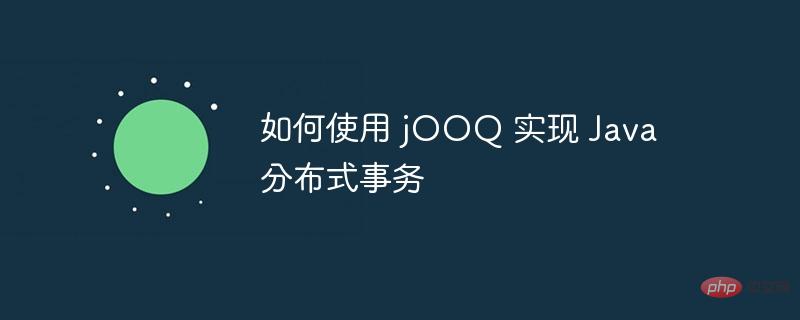Home >Java >javaTutorial >How to implement Java distributed transactions using jOOQ
How to implement Java distributed transactions using jOOQ
- WBOYWBOYWBOYWBOYWBOYWBOYWBOYWBOYWBOYWBOYWBOYWBOYWBOriginal
- 2024-06-03 11:33:561245browse
Implementing Java distributed transactions using jOOQ: Setting up multiple data sources and jOOQ dependencies. Start a transaction using the DSLContext.transaction() method. Perform operations on each data source in sequence. Commit the transaction or rollback on exception. Perform follow-up actions after the transaction is completed.

Implementing Java distributed transactions using jOOQ
Introduction
Distributed transactions involve transactions that span multiple databases or resources. jOOQ is a Java library that simplifies interaction with SQL databases and provides distributed transaction support.
Preparation
Before you begin, make sure you meet the following prerequisites:
- Java development environment
- jOOQ dependency has been added to
- Multiple databases or resources in your project can be used for transactions
Code examples
The following examples demonstrate how to implement distributed transactions using jOOQ:
import org.jooq.*;
import org.jooq.conf.Settings;
class DistributedTransactionExample {
public static void main(String[] args) {
// 设置数据库连接
DataSource dataSource1 = ...;
DataSource dataSource2 = ...;
// 创建配置并使用两个数据源
Settings settings = new Settings();
settings.setExecuteLogging(true);
DSLContext ctx1 = DSL.using(dataSource1, settings);
DSLContext ctx2 = DSL.using(dataSource2, settings);
// 启动事务
ctx1.transaction(configuration -> {
try {
// 在第一个数据源上执行操作
ctx1.update(TABLE1).set(COLUMN1, VALUE1).where(CONDITION1).execute();
// 在第二个数据源上执行操作
ctx2.update(TABLE2).set(COLUMN2, VALUE2).where(CONDITION2).execute();
// 提交事务
configuration.commit();
} catch (Exception e) {
// 回滚事务
configuration.rollback();
throw e;
}
});
// 这里的事务操作已完成
}
}Description:
-
DSLContext.transaction()method is used to start a distributed transaction. - The order of operations in the callback is the same as the order of submission.
- If an exception occurs on any data source, the transaction will be rolled back.
- After the transaction is successfully submitted, subsequent operations can be performed after the callback is completed.
Practical case
The following is a practical case of distributed transactions:
An e-commerce platform needs to update data in both order and inventory databases at the same time. Using jOOQ, reliable distributed transactions can be implemented to ensure that the data in the two databases remains consistent.
Conclusion
Using jOOQ to implement distributed transactions is a relatively intuitive process. By using the DSLContext.transaction() method and appropriate configuration, you can achieve reliable data consistency in complex systems.
The above is the detailed content of How to implement Java distributed transactions using jOOQ. For more information, please follow other related articles on the PHP Chinese website!
Related articles
See more- Distributed database and distributed transaction technology in PHP
- How to use Redis and C# to implement distributed transaction functions
- How to use MySQL's distributed transactions to handle large-scale concurrent requests
- Jooq and postgres: pg_trgm operator in pure sql produces error 'operator does not exist'

